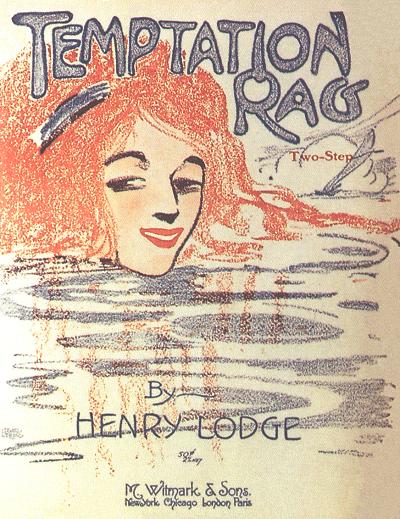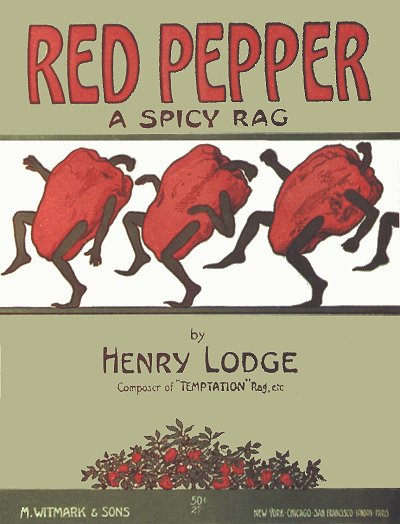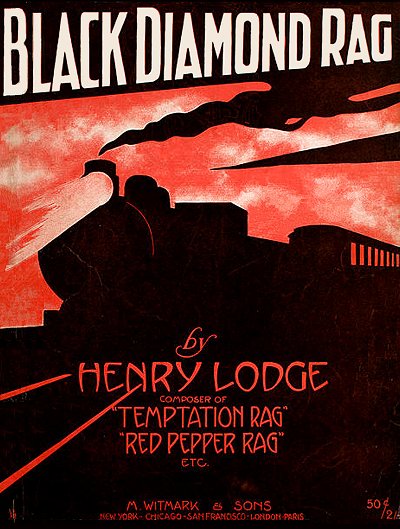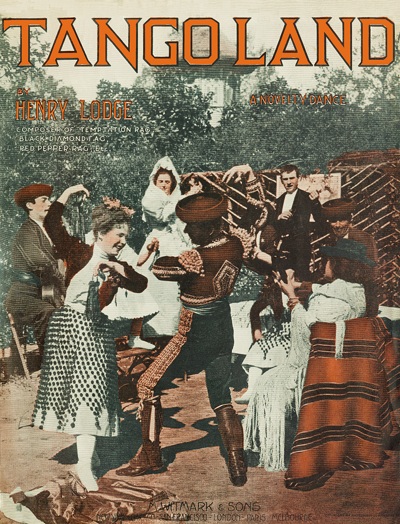|
Thomas Henry Lodge (February 9, 1884 to February 16, 1933) | |
 Known Compositions Known Compositions | |
|
1904
At the Ball - Piano CapriceVictorious Eagle - March 1909
Skylark - IntermezzoTemptation Rag Temptation Rag Song [1] 1910
Ole South - A Plantation DanceSure Fire Rag Sneaky Shuffles Red Pepper, A Spicy Rag 1911
The Roulette Reel: A Parisian PranceDixie Daisy Dear [2] 1912
Voice of the Cello - Waltz [3]Black Diamond: A Rag Sparkler Tokio Rag Tango Land Some Other Time [4] My Tango Maid [5] 1913
Moonlight RagPastime Rag The Cabaret Glide [5] Rub Dubby Dub [5] 1914
My Heart's Tonight in Erin [6]He's Working in the Movies Now [7] The Egyptian Trot Fascination Waltz Oh You Turkey The Boston Stop Demi-Tasse Cupid's Caprice 1915
Silver FoxGeraldine Hill and Dale Gum Drops 1917
The Baltimore BluesRemorse Blues Eveline: Geraldine's Sister In the Spotlight: Waltz [8] |
1918
Making CiderThe Bounding Buck Misery Blues Hifalutin Rag 1921
Shadow DreamsHaunting: Waltz Answering Fooling Me 1922
Gypsy Rose [9]1923
Wireless WaveletsIn a Tea Garden: A Japanese Romance That Red Head Gal [10] 1924
Moonlight Silhouettes1925
Moon Madness: IntermezzoRose of the Moonlight [11] 1926
Baiser d'Amour1927
Indian Butterfly (Namoi) [11,12]1928
Bunny Hug1929
Missouri Moon [13]Forget Me [14] I Can't Remember the Words [15]
1. w/Louis Weslyn
2. w/Bert Fitzgibbons 3. w/Leon Rogee 4. w/Jack Brockman 5. w/Jean Havez 6. w/Tom Henry 7. w/Vincent Bryan & Harry Williams 8. w/Nick Nichols 9. w/Robert Stark 10. w/Gus Van & Joe Schenck 11. w/Edgar Leslie 12. w/Billy Stone 13. w/Mitchell Parish 14. w/Irving Kahal & Willie Raskin 15. w/Milton Ager & Jack Yellen |
Thomas H. Lodge was born in Lymansville, Rhode Island, part of North Providence, to British father Edward Lodge and his wife Joanna Lynch, a Maryland native of Irish descent. He was the oldest of four brothers and one older sister. His siblings included Annie (8/1883), Edward A. (1885), Lyman Alfred (1/1891) and Walter (5/1898). His father worked in the Providence Woolen Mill, as had many of his siblings since their own father died in the late 1860s. In spite of seemingly non-musical parentage, Thomas took well to the piano, and was able to find employment after high school demonstrating and selling pianos. By 1900 his father Edward had died and his mother Joanna was running their home as a boarding house. Within a few years Thomas had published a couple of his early pieces. As per the 1905 Rhode Island census, Thomas was still living with his mother and two of his brothers, Lyman and Walter. Lodge was married in 1906 to Sarah Agnes Mackie, and they had a child, Mary Frances, late the following year.
He was the oldest of four brothers and one older sister. His siblings included Annie (8/1883), Edward A. (1885), Lyman Alfred (1/1891) and Walter (5/1898). His father worked in the Providence Woolen Mill, as had many of his siblings since their own father died in the late 1860s. In spite of seemingly non-musical parentage, Thomas took well to the piano, and was able to find employment after high school demonstrating and selling pianos. By 1900 his father Edward had died and his mother Joanna was running their home as a boarding house. Within a few years Thomas had published a couple of his early pieces. As per the 1905 Rhode Island census, Thomas was still living with his mother and two of his brothers, Lyman and Walter. Lodge was married in 1906 to Sarah Agnes Mackie, and they had a child, Mary Frances, late the following year.
 He was the oldest of four brothers and one older sister. His siblings included Annie (8/1883), Edward A. (1885), Lyman Alfred (1/1891) and Walter (5/1898). His father worked in the Providence Woolen Mill, as had many of his siblings since their own father died in the late 1860s. In spite of seemingly non-musical parentage, Thomas took well to the piano, and was able to find employment after high school demonstrating and selling pianos. By 1900 his father Edward had died and his mother Joanna was running their home as a boarding house. Within a few years Thomas had published a couple of his early pieces. As per the 1905 Rhode Island census, Thomas was still living with his mother and two of his brothers, Lyman and Walter. Lodge was married in 1906 to Sarah Agnes Mackie, and they had a child, Mary Frances, late the following year.
He was the oldest of four brothers and one older sister. His siblings included Annie (8/1883), Edward A. (1885), Lyman Alfred (1/1891) and Walter (5/1898). His father worked in the Providence Woolen Mill, as had many of his siblings since their own father died in the late 1860s. In spite of seemingly non-musical parentage, Thomas took well to the piano, and was able to find employment after high school demonstrating and selling pianos. By 1900 his father Edward had died and his mother Joanna was running their home as a boarding house. Within a few years Thomas had published a couple of his early pieces. As per the 1905 Rhode Island census, Thomas was still living with his mother and two of his brothers, Lyman and Walter. Lodge was married in 1906 to Sarah Agnes Mackie, and they had a child, Mary Frances, late the following year.In 1909, Temptation Rag was published, and quickly became a hit in the stores and on the vaudeville circuit. It received accolades not only in the trades and the press, but from his peers as well. One such mention appeared in the New York Clipper in early 1910:
One such mention appeared in the New York Clipper in early 1910:
 One such mention appeared in the New York Clipper in early 1910:
One such mention appeared in the New York Clipper in early 1910:Mike Bernard, that "Wizard of the Piano," has in his repertory several numbers that possess excellent qualities. Noticeable among these is Henry Lodge's "Temptation Rag." The success of this number is remarkable, and fully supports its appropriate title, "Temptation," for it is positively one of the most tempting numbers that has yet been given the public...
Temptation Rag was soon followed by Sure Fire and Red Pepper, A Spicy Rag, which were also popular sellers. Again from the New York Clipper of mid-1910: "Some of the biggest dancing acts are making the assertion that the 'Sure Fire Rag,' by Henry Lodge, is the best buck, wing and step dance that has been published in years." The Lodge family was shown as still living in Providence in 1910, Lodge now using Henry as his name, and listed as a musical director for a local vaudeville company. Sarah was listed as a servant, which is unusual as the family boarded in the same house as her brother and father, who both worked in the same woolen mill as Lodge's father had.
In 1912, Lodge moved his family from Rhode Island to New York City. After stints in bars and cabarets, he landed a job with the famous dancing duo, Irene and Vernon Castle. Lodge became their lesson pianist at their ritzy dance studio. Some of his 1914 dance numbers came out of this experience. He also played for some Vaudeville outfits and started working on more advanced ragtime that was much more harmonically complex than his earlier works. One of Lodge's longest-lasting works from this time frame is the enchanting ragtime waltz Geraldine. He followed it up with the less successful Eveline: Geraldine's Sister two years later.
Working free-lance for many years, usually through M. Witmark & Sons, Henry finally got a coveted contract with them in 1917. According to an article in the Music Trade Review of November 17, 1917:
M. Witmark & Sons have entered into arrangements with Henry Lodge to publish the latter's compositions exclusively for a term of years. The Witmark catalog already includes a number of Mr. Lodge's instrumental pieces, including the famous "Temptation Rag," "Black Diamond Rag," "Red Pepper Rag" and many others. The popular "Geraldine Waltz" is another of Mr. Lodge's well-known numbers.
In 1918, the family relocated again to Atlantic City, New Jersey for the summer season. He was listed there in September 1918 as a musician employed by the Martinique Cafe on Kentucky Avenue (red for Monopoly fans). His wife Sarah (a.k.a. Sadie) died on August 6, 1918, in Rhode Island, possibly from the Spanish flu pandemic. While her immediate disposition was not known, Mary possibly went to live with other relatives for a while, and eventually married a Chester Lee Ferguson of Los Angeles, where they were found in the 1930s in voter records.
His wife Sarah (a.k.a. Sadie) died on August 6, 1918, in Rhode Island, possibly from the Spanish flu pandemic. While her immediate disposition was not known, Mary possibly went to live with other relatives for a while, and eventually married a Chester Lee Ferguson of Los Angeles, where they were found in the 1930s in voter records.
 His wife Sarah (a.k.a. Sadie) died on August 6, 1918, in Rhode Island, possibly from the Spanish flu pandemic. While her immediate disposition was not known, Mary possibly went to live with other relatives for a while, and eventually married a Chester Lee Ferguson of Los Angeles, where they were found in the 1930s in voter records.
His wife Sarah (a.k.a. Sadie) died on August 6, 1918, in Rhode Island, possibly from the Spanish flu pandemic. While her immediate disposition was not known, Mary possibly went to live with other relatives for a while, and eventually married a Chester Lee Ferguson of Los Angeles, where they were found in the 1930s in voter records.While neither Lodge or his daughter were located in the 1920 census, he was living in Manhattan according to some newspaper items. Henry was also making somewhat of a shift in his career from composer to writer, specifically working on movie scenarios, a lucrative field that really needed all the help it could get. According to a listing in the May 14, 1920 New York Times and in Variety, Lodge officially incorporated himself into this field: "Henry Lodge Photo Plays, Manhattan, $100,000; H. Lodge, J. Harris, W. Salisbury, 1545 Broadway." Henry had not totally given up his music work, and was still in demand, but this was a sizable investment into what had the potential to become a successful business. Nothing of substance appears to have come from the venture.
In the early 1920s, Lodge followed the lead of associates like Charles "Luckey" Roberts and started working with an orchestra in wealthy Palm Beach, Florida. During that time he remarried to Irene Lodge of Boston, Massachusetts, 18 years his junior, and had three more children, Sally, Theodore and Arthur. According to their birth locations, he lived in Boston from around 1924 to 1927, and was back in Manhattan in 1928. There was still song output with various lyricists, in part due to his contract with Witmark. When sound came to the movies around 1928, it was clear that the center of the music and movie business was going to quickly shift to the left, out to Hollywood. So he followed.
There was still song output with various lyricists, in part due to his contract with Witmark. When sound came to the movies around 1928, it was clear that the center of the music and movie business was going to quickly shift to the left, out to Hollywood. So he followed.
 There was still song output with various lyricists, in part due to his contract with Witmark. When sound came to the movies around 1928, it was clear that the center of the music and movie business was going to quickly shift to the left, out to Hollywood. So he followed.
There was still song output with various lyricists, in part due to his contract with Witmark. When sound came to the movies around 1928, it was clear that the center of the music and movie business was going to quickly shift to the left, out to Hollywood. So he followed.Lodge got work in Los Angeles, California, likely either through his photoplay company or the remnants of it since it was soon out of business. He is shown in the 1930 census in Los Angeles with Irene and their three children, listed as an author of fiction, which may or may not have been associated with the film industry. Mary was likely married by this time. It was a temporary relocation as the couple still maintained a Randolph, Massachusetts address. Curiously in both this census and a couple of other documents from that time he shows his birth state as Massachusetts, but the birth day and year remained the same.
A passenger list from November 3, 1930 shows Henry and his family returning from a trip through the Panama Canal to New York, presumably on their way back to the Boston area. Henry spent his last two years alternating between Palm Beach and New York while still based in Randolph. Thomas Henry Lodge unexpectedly died in Palm Beach just days after his 49th birthday. Irene would remarry within three years to a Mr. Harding, and her copyright renewals of Henry's rags would be taken under the name of Irene Lodge Harding, Whitman, Mass. Over the next two decades his Temptation Rag would grow in popularity until it became one of the more frequently recorded rags of the 1950s ragtime revival.
Thanks to Robert Lobo, great grandson of Henry Lodge via Mary Frances Lodge, for additional information on her disposition after her mother's death.